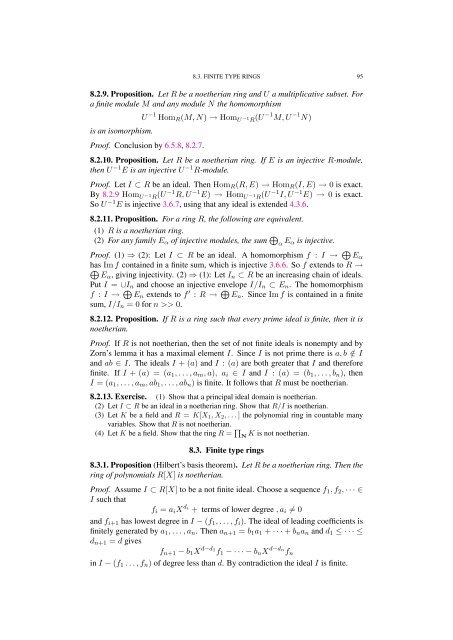Commutative algebra - Department of Mathematical Sciences - old ...
Commutative algebra - Department of Mathematical Sciences - old ...
Commutative algebra - Department of Mathematical Sciences - old ...
Create successful ePaper yourself
Turn your PDF publications into a flip-book with our unique Google optimized e-Paper software.
8.3. FINITE TYPE RINGS 95<br />
8.2.9. Proposition. Let R be a noetherian ring and U a multiplicative subset. For<br />
a finite module M and any module N the homomorphism<br />
is an isomorphism.<br />
U −1 HomR(M, N) → Hom U −1 R(U −1 M, U −1 N)<br />
Pro<strong>of</strong>. Conclusion by 6.5.8, 8.2.7.<br />
8.2.10. Proposition. Let R be a noetherian ring. If E is an injective R-module,<br />
then U −1 E is an injective U −1 R-module.<br />
Pro<strong>of</strong>. Let I ⊂ R be an ideal. Then HomR(R, E) → HomR(I, E) → 0 is exact.<br />
By 8.2.9 Hom U −1 R(U −1 R, U −1 E) → Hom U −1 R(U −1 I, U −1 E) → 0 is exact.<br />
So U −1 E is injective 3.6.7, using that any ideal is extended 4.3.6.<br />
8.2.11. Proposition. For a ring R, the following are equivalent.<br />
(1) R is a noetherian ring.<br />
(2) For any family Eα <strong>of</strong> injective modules, the sum <br />
α Eα is injective.<br />
Pro<strong>of</strong>. (1) ⇒ (2): Let I ⊂ R be an ideal. A homomorphism f : I → Eα<br />
has Im f contained in a finite sum, which is injective 3.6.6. So f extends to R →<br />
Eα, giving injectivity. (2) ⇒ (1): Let In ⊂ R be an increasing chain <strong>of</strong> ideals.<br />
Put I = ∪In and choose an injective envelope I/In ⊂ En. The homomorphism<br />
f : I → En extends to f ′ : R → En. Since Im f is contained in a finite<br />
sum, I/In = 0 for n >> 0.<br />
8.2.12. Proposition. If R is a ring such that every prime ideal is finite, then it is<br />
noetherian.<br />
Pro<strong>of</strong>. If R is not noetherian, then the set <strong>of</strong> not finite ideals is nonempty and by<br />
Zorn’s lemma it has a maximal element I. Since I is not prime there is a, b /∈ I<br />
and ab ∈ I. The ideals I + (a) and I : (a) are both greater that I and therefore<br />
finite. If I + (a) = (a1, . . . , am, a), ai ∈ I and I : (a) = (b1, . . . , bn), then<br />
I = (a1, . . . , am, ab1, . . . , abn) is finite. It follows that R must be noetherian.<br />
8.2.13. Exercise. (1) Show that a principal ideal domain is noetherian.<br />
(2) Let I ⊂ R be an ideal in a noetherian ring. Show that R/I is noetherian.<br />
(3) Let K be a field and R = K[X1, X2, . . . ] the polynomial ring in countable many<br />
variables. Show that R is not noetherian.<br />
(4) Let K be a field. Show that the ring R = <br />
N K is not noetherian.<br />
8.3. Finite type rings<br />
8.3.1. Proposition (Hilbert’s basis theorem). Let R be a noetherian ring. Then the<br />
ring <strong>of</strong> polynomials R[X] is noetherian.<br />
Pro<strong>of</strong>. Assume I ⊂ R[X] to be a not finite ideal. Choose a sequence f1, f2, · · · ∈<br />
I such that<br />
fi = aiX di + terms <strong>of</strong> lower degree , ai = 0<br />
and fi+1 has lowest degree in I − (f1, . . . , fi). The ideal <strong>of</strong> leading coefficients is<br />
finitely generated by a1, . . . , an. Then an+1 = b1a1 + · · · + bnan and d1 ≤ · · · ≤<br />
dn+1 = d gives<br />
fn+1 − b1X d−d1 f1 − · · · − bnX d−dn fn<br />
in I − (f1 . . . , fn) <strong>of</strong> degree less than d. By contradiction the ideal I is finite.
















